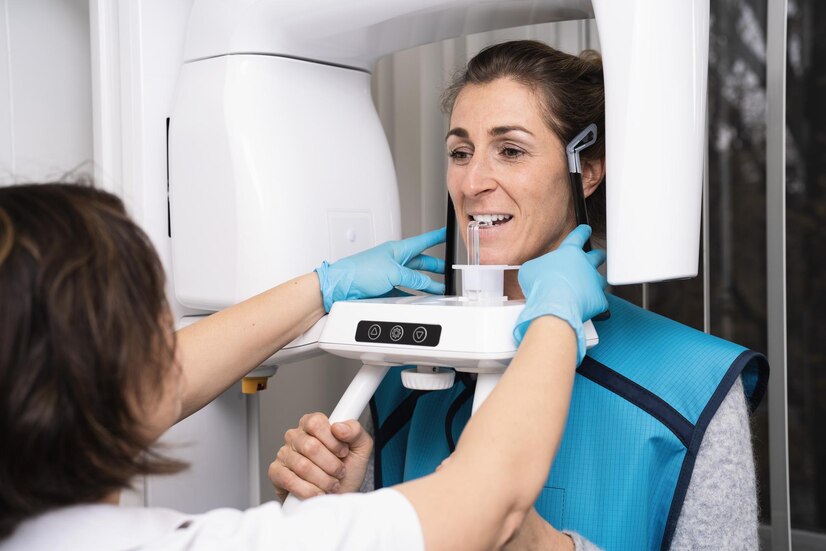Ever needed a dental X-ray that captured your entire jawline in one go? If so, you’ve likely encountered the OPG or Orthopantomogram. This specialised X-ray technique offers a wide view of your entire mouth, making it a valuable tool for dentists. But what exactly is an OPG, and how does it work? Don’t worry, this article will be your friendly guide, explaining everything you need to know about OPG CT scans.
What is an OPG CT Scan?
An OPG CT scan is a special type of dental X-ray that provides a panoramic image of your mouth, including your upper and lower jaws, teeth (even those hidden beneath the gum line), and even some surrounding structures like the sinuses. Unlike regular dental X-rays that focus on specific teeth, the OPG captures everything in one broad sweep, making it a one-stop shop for dentists to assess your overall dental health.
Why is it Called Orthopantomogram?
The term “Orthopantomogram” might sound intimidating, but let’s break it down. “Ortho” refers to “straight” or “correct,” “pan” stands for “all-encompassing,” “tomo” indicates “slice,” and “gram” refers to “recording.” So, an Orthopantomogram is a recording of a complete, straight slice of your jaw and teeth.
How Does an OPG X-Ray Work?
The entire process of obtaining an OPG is usually quick, taking only a few minutes to complete. Here’s a breakdown of what happens during an OPG scan:
Preparation
You’ll be positioned comfortably with your head securely positioned within the OPG machine. You may need to bite on a special holder to ensure proper positioning. Any metal objects like jewellery or piercings will be removed to avoid interference with the X-ray image.
The X-Ray Capture
The machine arm with the X-ray source and sensor will gently rotate around your head, capturing multiple X-ray images at different angles. This creates a comprehensive view of your entire jaw structure.
Image Processing
The captured X-ray images are then digitally processed by a computer to generate a single, panoramic image. This final image is what your dentist will use for analysis.
What Can an OPG X-Ray Show?
An OPG X-ray goes beyond just showing your dentist a picture of your mouth. It’s a powerful diagnostic tool that is helpful for dentists in diagnosing and evaluating various dental conditions. Here are some key things an OPG can reveal:
Wisdom Teeth
Are your wisdom teeth coming in impact? The OPG can show their position and potential problems like crowding or angulation. This information helps your dentist plan a safe and effective wisdom teeth extraction strategy.
Orthodontic Assessment
Planning braces or other orthodontic treatments? The OPG helps assess jaw development, tooth positioning, and root alignment, allowing for a more precise treatment plan and improved treatment outcomes.
Keeping an Eye on Jaw Development
The OPG provides a panoramic view of your jawbone, allowing your dentist to assess its health and development. This is particularly valuable for children and teenagers, as it can help identify potential issues like jawbone deficiencies that might affect future orthodontic treatment.
TMJ Troubles
If you’re experiencing jaw pain or clicking, then the OPG can sometimes provide clues about the health of your temporomandibular joint (TMJ), which connects your jaw to your skull. This information can be crucial for diagnosing and treating TMJ disorders.
Sinus Surprise
While not the primary focus, the OPG can sometimes show signs of sinusitis, an inflammation of the sinuses located near the jaw. This unexpected benefit can help your dentist identify potential sinus-related issues that might be contributing to other facial pain or discomfort.
| Feature | Conventional Dental X-Ray | OPG CT Scan |
|---|---|---|
| Imaging Technique | Intraoral and stationary | Panoramic and rotating |
| Coverage Area | Specific areas within the mouth | Upper and lower jaws, teeth, sinuses, TMJ (sometimes) |
| Image Detail and Quality | High detail in specific areas | Broad overview with sufficient detail |
| Purpose | Diagnose cavities, decay, and bone loss around teeth | Assess jaw development, wisdom teeth position, jawbone health, TMJ issues, orthodontic planning, implant planning, and sinus issues |
| Radiation Exposure | Low | Low, however, higher than conventional X-Ray |
| Procedure Time | Few minutes | Slightly longer (but in minutes) |
| Cost | Generally lower | Generally higher |
The Benefits of an OPG Scan
Comprehensive view
Provides a single, broad image of your entire jaw and teeth, reducing the need for multiple X-rays and allowing dentists to identify potential issues that might go unnoticed with regular X-rays.
Early detection
OPG scans can help to detect dental problems early on when they are easier to treat. This can help to prevent more serious problems from developing down the road.
Convenience
OPG scans are quick and easy to take. The procedure is typically painless and only takes a few minutes to complete.
Low radiation dose
OPG scans use a low dose of radiation. While there is always a small risk associated with any radiation exposure, the benefits of OPG scans typically outweigh the risks.
Key Takeaway
An OPG scan is a valuable tool in modern dentistry. It provides detailed information about your jaw and teeth, allowing dentists to diagnose and plan treatment effectively. If your dentist recommends an OPG scan, don’t hesitate to ask questions and discuss any concerns you might have. With its benefits outweighing the minimal risks, an OPG scan can be a key step towards maintaining good oral health.
Why Choose Radiology Imaging Solutions for Your OPG Scan?
At Radiology Imaging Solutions, we’re passionate about helping you achieve optimal oral health. Our team of qualified professionals ensures a smooth and comfortable experience. We utilise state-of-the-art equipment to deliver high-quality, OPG scans with minimal radiation exposure. With us, you can get your results quickly, allowing for a swift discussion with your dentist and start treatment plan sooner.

